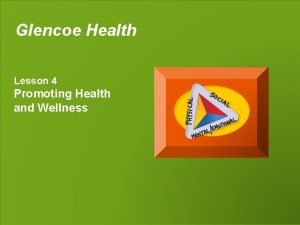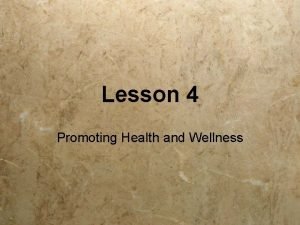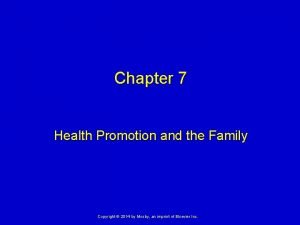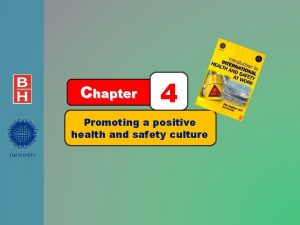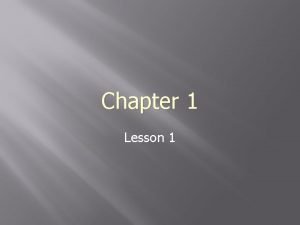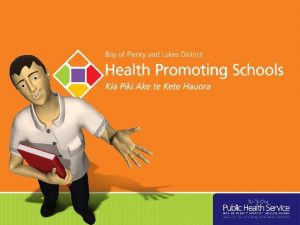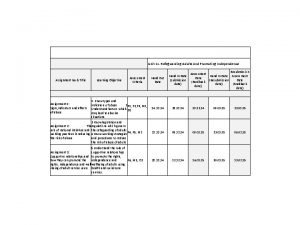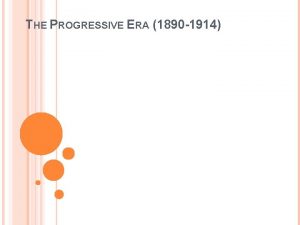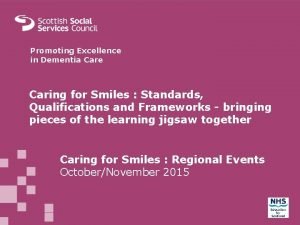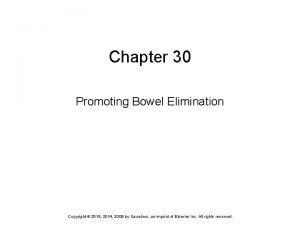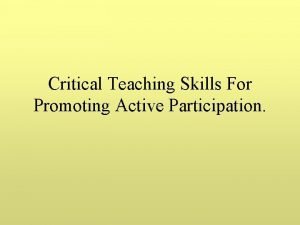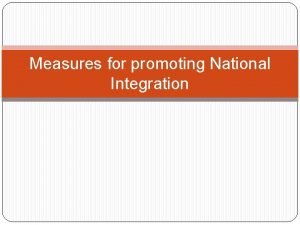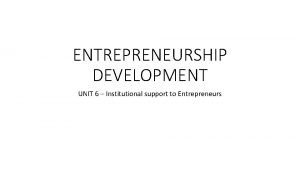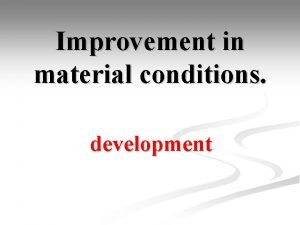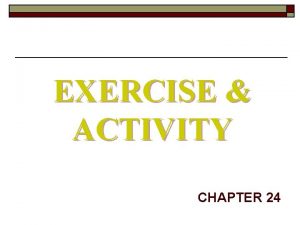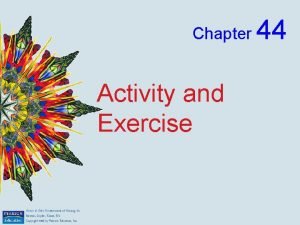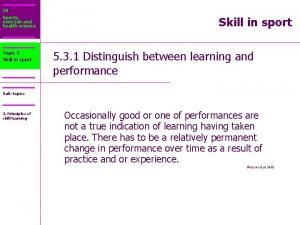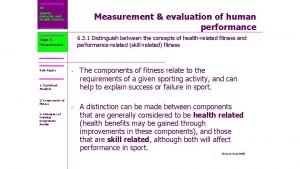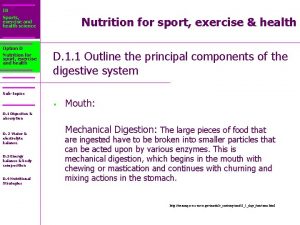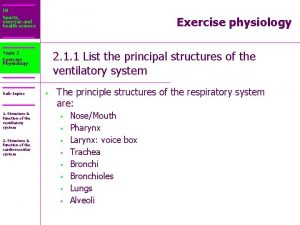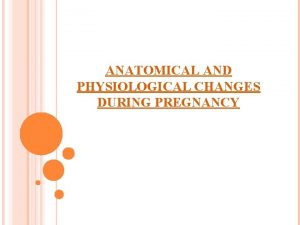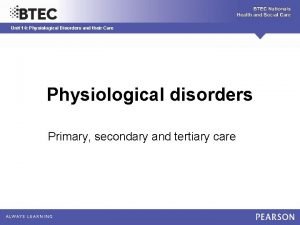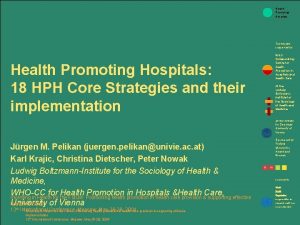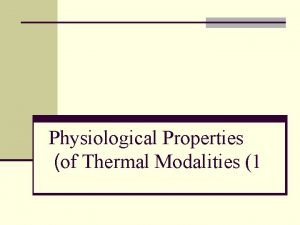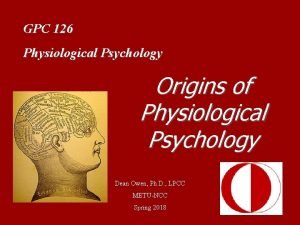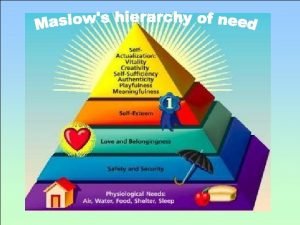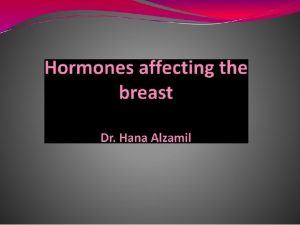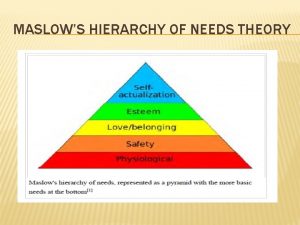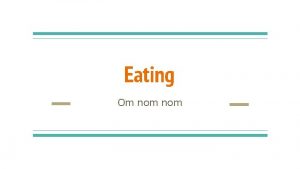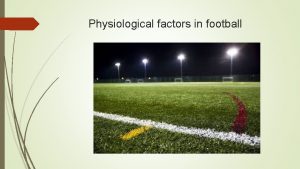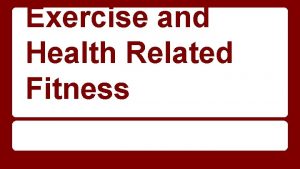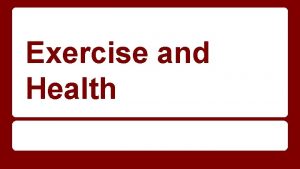Promoting Physiological Health Activity and Exercise Activity Exercise

































- Slides: 33

Promoting Physiological Health Activity and Exercise

Activity Exercise pattern Refers to person’s routine exercise, activity, leisure, and recreation. It includes activities of daily living (ADL) such as hygiene, eating and drinking

Mobility The ability to move freely, easily, rhythmically, and purposefully in the environment

Body Movement Alignment and Posture • Line of gravity • Centre of gravity • Base of support

Body Movement Joint mobility Joints are the functional units of the musculoskeletal system Range of Motion (ROM): maximum movement possible for that joint

Joint Movements Flexion: decreasing the angle of the joint Extension: Increasing angle of the joint Hyper extension: further extension or straightening a joint Abduction: bone moved away from midline of the body Adduction: bone toward the body midline Rotation: bone around its central axis Circumduction: distal part in full circle Eversion: sole outward Inversion: sole inward Pronation: hand faces downward Supination: hand faces upwrad.

Body Movement Balance MECHANISM OF BALANCE (sense f balance): - labyrinth - vetibulo-ocular input - receptors of muscles and tendons (vestibulo spinal input)

Body Movement Coordinated movement Balanced, smooth, purposeful movement

Physical activity Bodily movement produced by skeletal muscles that requires energy expenditure and produces progressive health benefits. Exercise: type of physical activity, planned, structured, and repetitive bodily movement to improve or maintain physical fitness.

Types of Exercise Dynamic (Isotonic) (running, walking) (pulling, lifting buttocks in bed) Isometric (static, setting) (extending leg in bed) Isokinetic (resistive) using machines in building up exercises Aerobic

Benefits of Exercise To prevent immobility effects Bed rest

Benefits of Exercise On musculoskeletal system: - Disuse osteoporosis - Disuse atrophy (muscles decrease in size loosing strength and function) - contracture: permanent muscle shortening (foot drop) - stiffness and pain in joints (ankylosed-immobile joints)

Benefits of Exercise On Cardiovascular System - Tachy cardia with minimal exertion as effects of diminished cardiac reserve - Valsalva maneuver : results in tachy cardia and arrhythmias - orthostatic hypotension - venous vasodilatation and stasis (incompetent valves) - Dependent edema - Thrombus formation (thrombophlebitis) (a clot that is loosely attached to an inflamed vein wall), it may break into embolus formation.

Benefits of Exercise On Respiratory system - decreased respiratory movement - Pooling respiratory secretions (in ability to cough) as aresult of respiratory muscles weakness - Atelectasis - Hypostatic pneumonia

Benefits of Exercise On metabolic system - decreased metabolic rate - Negative nitrogen balance - Anorexia : loss of appetite - negative calcium balance : absence of weight bearing

Benefits of Exercise On urinary system - urinary stasis - Renal calculi (stones) - Urinary retention (accumulation of urine in bladder) - urinary tract infection

Benefits of Exercise On GIT system - constipation On integumentary system - reduced skin turgor - skin breakdown

Nursing Interventions to promote Activity and Exercise Using body mechanics: facilitate the safe and efficient use of appropriate muscle groups to maintain balance, reduce energy, reduce fatigue, and decrease the risk for injury

Nursing Interventions to promote Activity and Exercise Lifting: - carrying out objects (patients). - use a lever principle when lifting - flex knees and back when lifting objects from the floor to waist - keep distance 30 cm between the feet

Nursing Interventions to promote Activity and Exercise Pulling and pushing: In pushing, enlarged base of support by moving front foot forward

Nursing Interventions to promote Activity and Exercise Pivoting: placing one foot ahead of the other, raise the heels very slightly and put the body weight on the balls of the feet.

Nursing Interventions to promote Activity and Exercise Prevent lower back injury: - poor standing and sitting - overweight - wearing high-heeled shoes

Nursing Interventions to promote Activity and Exercise Patient positioning : It helps to prevent muscle discomfort, pressure ulcers, contractures, damaged nerves and blood supply. It also maintains muscle tone and stimulate postural reflexes.

Nursing Interventions to promote Activity and Exercise Positioning guidelines: - firm mattress and support the body and feet - bed is clean and dry, avoid wrinkles and damp - place support devices: flexion of neck, Internal rotation of the shoulder, adduction of the shoulder, flexion of the wrist, anterior convexity of lumbar spine, external rotation of the hips, hyper extension of the knees, planter flexion of the ankle. - Avoid placing one body part on another

Nursing Interventions to promote Activity and Exercise Patient positioning - Fowler’s position (head and trunk raised 45 -90 degrees). In low. Fowler’s and Semi-Fowler’s (15 -45 degrees). High Fowler’s (90 degrees) Indications: dyspnea, heart conditions

Nursing Interventions to promote Activity and Exercise Orthopneic position Allowing maximum chest expansion. Indicated to patients with exhaling problems such as COPD. Dorsal Recumbent position (supine) indicated to provide comfort and healing post surgery

Nursing Interventions to promote Activity and Exercise Prone position indicated for full extension of the hip and knees and prevent contractures, but may cause planter flexion. Not indicated in cardiac and respiratory disorders, cervical lumber spine. Lateral position: for rest and sleep, relief pressure on hip and sacrum,

Nursing Interventions to promote Activity and Exercise Sims’ position (semi-prone) indicated for unconscious patients, paralyzed patients, receiving enema and anal examination, suitable for pregnant women.

Nursing Interventions to promote Activity and Exercise Moving and turning patient in bed - assess for patient’s physical abilities - pain relief - supportive equipments - assistance - raise the height of the bed - lock wheels - prevent spinal twisting - increase stability - lean trunk forward - tighten muscles - after moving the patient, make sure that he/she comfortability

Nursing Interventions to promote Activity and Exercise Moving patient up in bed: - flexing hip and knees - grasp trapez, or head of the bed - two nurses using a hand- forearm interlock or turn sheet - logrolling: a technique used to turn the patient whose body must at all times be kept in straight alignment such as spinal injury. - turning from supine to prone or lateral positions.

Nursing Interventions to promote Activity and Exercise Assist patient to sit on the side of the bed (dangling) Teach the patient (e. g. CVA) how to sit on the side of the bed independently. Transferring clients: bed to chair, using sliding board, belt, hoist (hydraulic lift) or three-person carry

Nursing Interventions to promote Activity and Exercise Providing ROM Exercises (active and passive) Patient ambulation (act of walking) -pre-ambulation exercises - assist client to ambulate (one nurse or two nurses) - lowering fainting patient to floor

Nursing Interventions to promote Activity and Exercise Using mechanical aids for walking - canes - Walkers - crutches
 Lesson 4 promoting health and wellness
Lesson 4 promoting health and wellness Lesson 4 promoting health and wellness
Lesson 4 promoting health and wellness Lesson 4 promoting health and wellness
Lesson 4 promoting health and wellness Chapter 7 promoting health and wellness
Chapter 7 promoting health and wellness Promoting a positive health and safety culture
Promoting a positive health and safety culture Health and wellness vocabulary
Health and wellness vocabulary Promoting infant health section 7-2
Promoting infant health section 7-2 Health promoting schools model
Health promoting schools model Health promoting school
Health promoting school Btec level 3 health and social care unit 14 coursework
Btec level 3 health and social care unit 14 coursework Activity and exercise pattern
Activity and exercise pattern Promoting services and educating customers
Promoting services and educating customers Chapter 13 distributing and promoting products
Chapter 13 distributing and promoting products Promoting services and educating customers
Promoting services and educating customers Unit 11 safeguarding adults and promoting independence
Unit 11 safeguarding adults and promoting independence When was the progressive era? *
When was the progressive era? * Promoting alternative thinking strategies
Promoting alternative thinking strategies Promoting family earthquake preparedness
Promoting family earthquake preparedness Promoting racial literacy in schools
Promoting racial literacy in schools Leaving cert business philip curry
Leaving cert business philip curry Promoting excellence in dementia care
Promoting excellence in dementia care Deontological ethics example situation
Deontological ethics example situation Chapter 30 promoting bowel elimination
Chapter 30 promoting bowel elimination Promoting active participation
Promoting active participation Need of national integration
Need of national integration Role of support institutions include
Role of support institutions include Japan's principal asset in promoting development is
Japan's principal asset in promoting development is Chapter 24 exercise and activity
Chapter 24 exercise and activity Activity and exercise fundamentals of nursing
Activity and exercise fundamentals of nursing Ib sports exercise and health science notes
Ib sports exercise and health science notes Ib sports exercise and health science
Ib sports exercise and health science Wolters kluwer
Wolters kluwer Sports
Sports Ib sport exercise and health science
Ib sport exercise and health science
